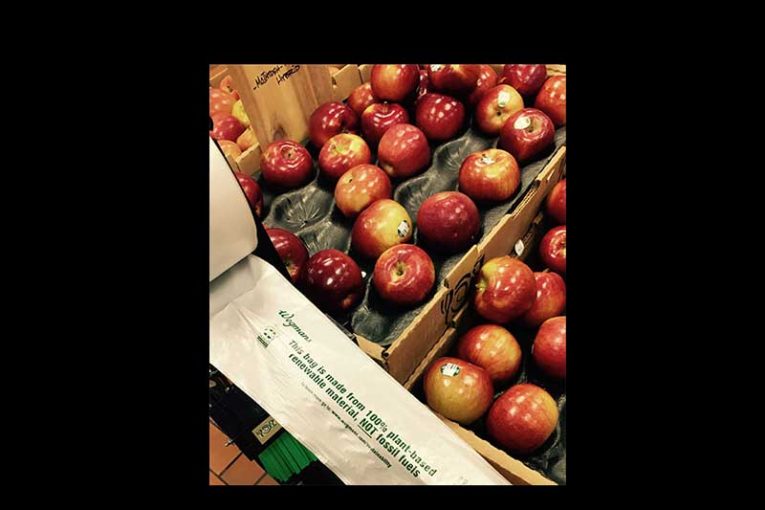Less Is More At Wegmans When It Comes To Packaging

With 92 stores across six states, each offering a minimum of 50,000 products, Wegmans Food Markets’ customers might not immediately equate the notion of “less is more” with the supermarket chain. But, when it comes to sustainability and the company’s commitment to reduce waste in landfills and reduce emissions, less truly is more, according to Wegmans.
Packaging innovation is just one example of how the Rochester, New York-based chain says it is delivering on that commitment.
“It’s always important to remember that a food container’s No. 1 job is to protect the food inside. It takes resources to grow that food, and fuel to bring it from the farm to the store, so we want to preserve nature’s investment in this food with containers that protect it all the way to your table,” said Jason Wadsworth, manager of sustainability for Wegmans. “Our job is to make sure packaging is functional, performs as expected and uses materials efficiently and responsibly. That leaves plenty of opportunity for exploring ways to make packaging more sustainable.”
To improve the sustainability of its packaging, Wegmans is focused on reducing the amount of virgin materials—new plastic or paper made from non-renewable fossil fuels—and replacing it with mineral fillers, and renewable and recycled materials. Wegmans says it also is committed to avoiding excess packaging and removing Bisphenol A (BPA) and other potentially harmful materials, such as Polystyrene and PVC where possible and where alternatives exist.
“As often happens with sustainability initiatives, the changes we’re implementing and the progress we’re making aren’t always easy to see,” said Wadsworth. “For some of the sustainable packages we’ve introduced, the change has been very apparent to customers, while for others, they’d never know unless we told them.”
Sustainable packaging solutions can be found across each of Wegmans’ stores.
Packaging innovations using less plastic:
• Wegmans recently introduced a new produce bag made from 100 percent plant-based renewable materials, not fossil fuels. During the manufacturing process, the use of plant-based materials means less CO2 is emitted and, unlike other renewable plastics, the new produce bags can be recycled in the same way as traditional plastic bags, by placing them in the plastic recycling depositories located in the vestibules of each Wegmans.
• Wegmans Organic Beef vacuum-sealed packaging is currently made from 50 percent plant-based renewable material, not fossil fuels and will be going to 70 percent plant-based this year.
• By switching to a bag from the plastic domes, each rotisserie chicken pouch uses 75 percent less plastic. In addition to being better for the environment, the bags offer an easy-carry handle, re-sealable zipper and are leak resistant, microwave safe and easy to store.
• In the Market Café, the self-serve food bar containers use 40 percent less plastic, as do the Choose Your Meal and pre-packaged Asian bowl containers in Prepared foods.
Packaging innovations using recycled content:
• Wegmans’ front-end plastic bags contain 40 percent post-consumer recycled content, all of which is generated by customers returning their plastic bags to the store. In 2016, Wegmans’ recycling rate for plastic bags averaged about 50 percent.
• Wegmans’ front-end plastic bags contain 40 percent post-consumer recycled content, all of which is generated by customers returning their plastic bags to the store. In 2016, Wegmans’ recycling rate for plastic bags averaged about 50 percent.
• Various plastic trays and containers are made from recycled plastic, such as fresh-cut veggie trays, made from 50 percent recycled plastic material.
• The paper “boats” used for product samples and the donut and cake boxes contain 100 percent recycled content.
Since 2015, Wegmans has saved more than 6 million pounds of virgin plastic resin by using mineral fillers, renewable materials and adding recycled material into its packaging. This combined plastic savings equates to 150 truckloads worth of packaging the company didn’t use.
When evaluating opportunities for improved packaging, Wegmans says it also looks for ways to shrink the carbon footprint involved in bringing food to customers. That’s why last fall, Wegmans says it converted its Food You Feel Good About Pasta Sauce from a glass jar to a lighter weight #1 PET plastic. Because the weight of an item plays a role in how many trucks are needed for shipment, Wegmans says it saw an opportunity to reduce the impact of transportation on the environment if the packaging of a high-volume item like pasta sauce could be made lighter, without sacrificing quality or safety.
“By switching from glass to PET jars,” said Wadsworth, “the same amount of pasta sauce can be shipped each year using 55 fewer trucks. That change can save 974 gallons of diesel fuel, cutting carbon dioxide emissions—the equivalent of driving around the Earth once in an average passenger vehicle.”
Although the glass jars were recyclable, PET plastic jars are more widely recycled, and are much less likely to break if dropped, minimizing food waste, another key reason Wegmans says it continues to look for ways to innovate in packaging.
Wegmans reports that it sees plenty of opportunity to continue reducing its reliance on virgin plastic and paper—not just for packaging, but in other areas of the store as well. In the Market Café, the plastic utensils are now made of 30 percent plant-based materials and are dispensed one at a time for a 30 percent reduction in waste, while the napkins are made with 100 percent recycled content. In its new stores, Wegmans is reducing the number of paper towels being used by introducing hand dryers in its restrooms.
“We’re very happy with the progress we’ve made over the last couple years, and we plan to keep the momentum going,” said Wadsworth. “Our 2017 goal is to reduce another half million pounds of packaging material by focusing on recycled content and renewable materials.”
No comments:
Post a Comment